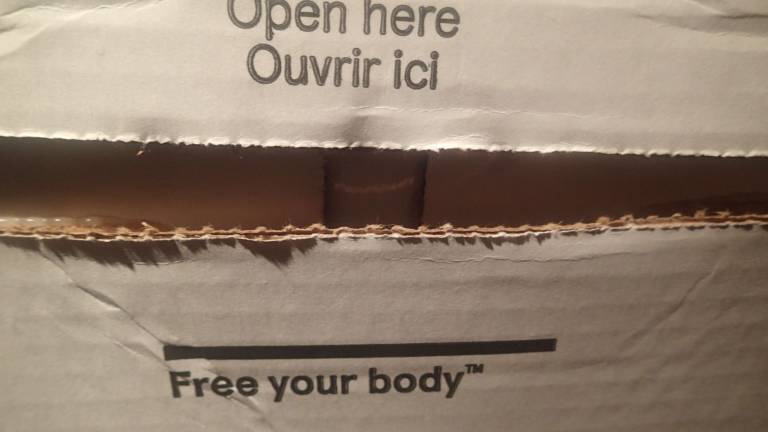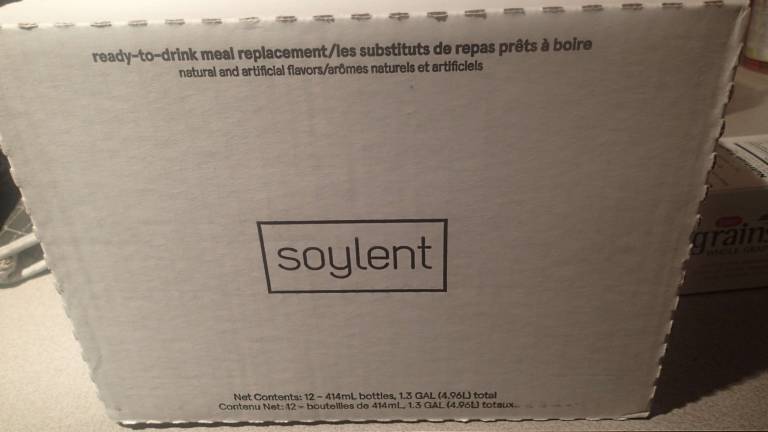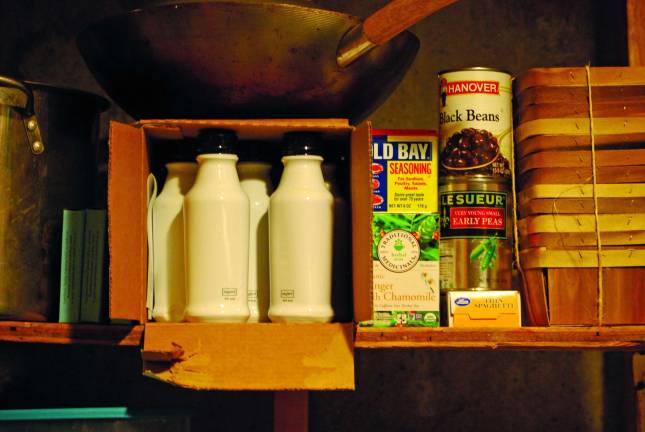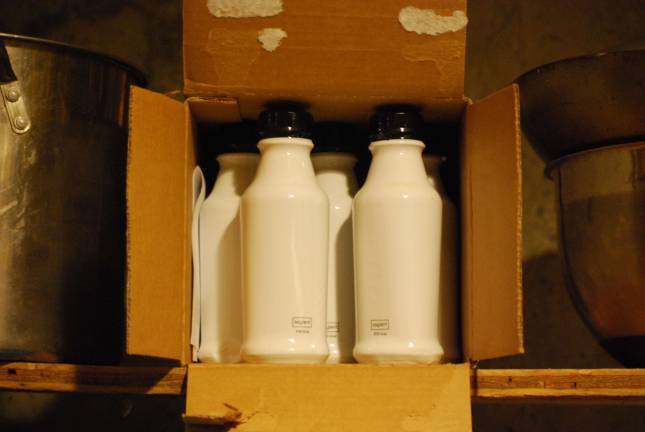The slurry life




“Is it made of people?”
That’s the response I get almost every time I tell someone about Soylent. It’s not made of people (as in its namesake 1970s sci-fi thriller) but that doesn’t stop them from being horrified when they learn what it really is: a nutritionally-complete shake meant to replace a meal. Each bottle contains 400 calories of nutrient slurry, precisely calibrated to have an ideal ratio of carbs to fat to protein. It’s soulless and utilitarian — and it’s fine with that.
Soylent is extraordinary in exactly zero ways besides its innovation, and it’s fine with that, too. Creator Rob Rhinehart, ultra-efficiency wunderkind, had exactly one goal in mind for his product: to feed people.
The word “feed” here is used in its most utilitarian sense. “Each serving of Soylent provides maximum nutrition with minimum effort,” states the website, www.soylent.me. The whole experience is void of frills and fun of any kind. Its packaging (plain white with black sans-serif text), its appearance (a beige so bland it’s hardly a color) and its taste (described variously as “cereal milk,” “totally neutral” and “sugarless milkshake”) all forego excitement or verve to the point of fetishism.
So what’s the appeal? To most people it’s less than zilch. Food is a pleasure to be savored, not a quota to be filled. But for a very specific demographic, the costs of food outweigh its benefits. Rhinehart was (metaphorically) fed up with the hours he spent purchasing, preparing and cleaning up after meals. So, like generations of industrialists and engineers before him, he found a way to minimize time spent doing things he didn’t like doing. He would rather get his calories with as little hassle as possible, taste and social conventions be damned.
And, it turns out, he’s not the only one. When introduced to the world at large, Soylent raised $800,000 in crowdsourced funds—more than any other crowdsourced food product ever. Since then, Rosa Labs has been tinkering with the recipe, increasing their production abilities and expanding their market (Canada recently got access; other countries are in the works). When I first ordered Soylent the wait list was months long. Now, a box arrives on your door three days after you place your first order.
The product has changed drastically since I got my first shipment. Since it was created by a bunch of tech geeks, Soylent versions are numbered like software: the first release was 1.0, I signed on at iteration 1.3, and my second shipment a month later was version 1.5. It is currently sold in two forms: 1.5 comes in bags full of 2000 calories’ worth of powder, to be mixed with water and used for one day’s nutrition. 2.0, the most recent addition, comes in the aforementioned white bottles. You don’t have to mix it yourself, but you would need five bottles per day for an all-Soylent diet.
My reasoning was for trying it out was simple, if vague: I think I eat pretty well, but I’d like to see what it feels like to get every bit of nutrition I need, every day. I’m a vegetarian, so things like protein and iron are problem areas. With Soylent, I wouldn’t have to worry about any of that. I figured I’d consume one bag a day and nothing else for a week and see how I felt.
That didn’t work out. My initial worry was that I’d have to force it down, but that wasn’t the case at all — it’s very inoffensive, even pleasant. The days when I poured a liter of sludge into my Nalgene and headed to work were fine. I wasn’t hungry, I didn’t have to spend $12 on a Manhattan salad, and I rested peacefully in the knowledge that my body was getting all the fuel it needed.
The problems arose when I got home. Who would have thought, but dinner is really good, especially after not having had a single bite of solid food all day. If I had forced myself I’m sure I could have gone a full week without food… but, really, what would be the point? There are dozens of blogs online detailing the trials of journalists, foodies and futurists who have gone X days without “real” food. Plus, besides the fact that Thai food is goddamn delicious, sharing a meal with my family is not something I’m willing to give up.
I haven’t had a meal of Soylent in a long while, but my girlfriend, a vegan, has a box of 2.0 in the fridge. On days when we can’t be bothered to cook, she’ll have half a bottle with half of whatever she gets for lunch, and then the other halves of both for dinner. Even such minimal use cuts down on food expenditures by the price of dinner (not so cheap in the San Francisco bay) and on food waste by whatever packaging and upstream waste a dinner would have implied. Her use pattern is what Rhinehart was aiming for: a life that is neither governed by the food industry nor a miserable, flavorless void, but something in the middle.
Food will never go away. It shouldn’t ever go away. Not only is its preparation and consumption an integral part of social units from families to pair-bonds to friend groups, but the psychological benefits of tasty foods are undeniable. Chocolate yields a dopamine rush. Spicy foods have a range of benefits from stimulating endorphins to reducing cancer risk. Red wine (debatably) has a slew of positive side effects leading to a longer lifespan. So no matter how popular Soylent is among the efficiency-minded and culinarily lazy, it will never be a popular solution for the general public.
It shouldn’t be. But it does have its benefits.
The website’s introductory video starts with a pilot crash landing on a Caribbean island, surrounded by the wreckage of his plane and a shipment of Soylent. It ends with his family joining him in a lovely self-constructed A-frame home, complete with hand-crank electricity, and the delivery of a new box of Soylent by a scuba diver. While they joyfully drink their joyless meal, the tagline appears: “Use less. Do more.”
Most of Soylent’s users are yuppie Silicon Valley tech workers, not resourceful castaways, but the message is clear: what is the real cost of food? On his personal blog entitled Mostly Harmless, Rhinehart explains that “Food is the fossil fuel of human energy. It is an enormous market full of waste, regulation, and biased allocation with serious geo-political implications.”
In an ideal world, he would be wrong. If everyone could grow their own food, or at least get their food from someone growing it nearby, the comparison to fossil fuels would be ridiculous. But it’s an analogy that makes a lot of sense in the urban environment. Just like the transport and refining of oil results in tons of fuel waste, the path a burger or loaf of bread takes from the field to the factory to the grocery store to the fridge is full of CO2 and methane emissions. Whether from the cow itself, from the truck that brings its meat to the store, or from the refrigerators that keep it cool, city-dwellers use a lot of energy on their meals. So while a conscientious chef may be able to cook a meal just as healthy and much less wasteful from veggies and protein bought at a local farmers’ market, their price tag and time spent can’t come close to competing with Soylent’s brute efficiency.
What’s more, our relationship with food in America is flawed at best, nightmarish at worst. This is the only time in history in which people can be both obese and malnourished. According to the Natural Resources Defense Council, the average American wastes 20 pounds of food each month, and supermarkets throw away much more than that. So anything that can pull us away from old (or, actually, new) ways of thinking about food and consumption is a much-needed step forward.
Of course there are downsides. I won’t touch on the scores of health bloggers who rend their hair and wring their hands, claiming that Soylent will do everything from give you cancer to make your teeth fall out—there’s no evidence for any of their claims, and whether or not people can really survive on nothing but Soylent a hypothesis that’s in the process of being proven.
Instead, I’ll look at issues of waste and sustainability, which are the issues Soylent claims to combat. It’s made sustainably, with half of its fat content coming from algae—but a day’s worth of nutrition means recycling five plastic bottles (or throwing away one non-recyclable bag), an unmistakable red flag in a product trying for perfect efficiency. 2.0, unlike the 1.x series, already contains water, meaning it’s less efficient to ship. But you also don’t have to refrigerate it, which you would with a mixed canister of 1.x. (Rhinehart is a diehard anti-refrigerist, which makes sense for his ethos—refrigerators were one of the appliances pushed hardest by the utility industry during the grow and build frenzy of the mid-20th century. That’s because they use a crazy amount of electricity, and they’re on all the time.) For those in Silicon Valley, a pure-Soylent diet might mean eating locally, but since as yet it only has one manufacturing center, for anyone else it requires a lot of transportation. In the end, whether or not it makes sense to switch depends on a lot of factors.
So, yes, there are problems. But Rhinehart and company are hard at work ironing out the bumps. And even taking into account its significant issues, Soylent could prove to have some serious social implications.
Think of the benefits to low-income populations. At $2.40 a meal and falling, it could be used to feed the hungry all over the world. It’s a dystopian answer to the hunger problem, but if we airlifted a thousand boxes of Soylent to every slum in India, starvation (not to mention diseases contracted from polluted water, since 2.0 contains around half the water a person needs in a day) would plummet. If Soylent was available for distribution after Hurricane Katrina, much of the chaos of the aftermath could have been avoided.
For those worried about the chaotic future — water wars, crop shortages, coastal flooding—it’s a great way to stockpile food (2.0 has a shelf life of a year, but the powder can survive indefinitely). The powder weighs in at around a pound per day per person, so as long as you have a good source of water, it’s far more efficient than stocking cans of beans and bags of rice, of which you’d need around three pounds per person per day. Plus it has all the vitamins and minerals you need, meaning you won’t get scurvy.
Until we face an apocalypse or a government-sponsored anti-hunger initiative, Soylent will remain a strange product for a niche market. But it turns out that niche market is bigger than expected. Almost as soon as Soylent went public, copycat companies started popping up. Manna, Joylent, Schmilk, Human Chow, and on and on. There’s even a healthy community of DIYers mixing up their own slurries from flax meal, chia seeds, soy lecithin granules, whey protein and whatever else they think will optimize their nutritional intake. It turns out that when you give people the option to cut down on “real” food, many are keen on the idea.
Most of the people I talk to about this are about as likely to switch to Soylent as they would a cut of human flank steak. Which is fine. It’s not aimed at everyone, and the world would be an awful place if family dinner consisted of huddling around a table sipping thin beige liquid from white bottles. But while it has all the appeal of… well, thin beige liquid, it does mark a turning point in our ideas about consumption — a tidal shift that is more necessary than welcome in an America that is literally and metaphorically glutted on its own consumerism.